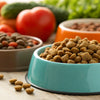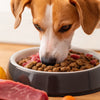Is Kibble for Cats or Dogs? Understanding the Nutritional Needs of Our Furry Friends
- Houndsy
Table of Contents
- Introduction
- The Basics: Understanding Kibble
- The Case for Fresh Food
- Designing a Balanced Diet for Pets
- The Role of the Houndsy Kibble Dispenser
- FAQs About Kibble and Pet Nutrition
- Conclusion
Introduction
As pet owners, we often face the dilemma of choosing the right food for our beloved companions. Did you know that approximately 60% of cats and 50% of dogs in the U.S. are overweight or obese? This alarming statistic underscores the importance of understanding what we feed our pets, especially when it comes to kibble. But the burning question remains: is kibble for cats or dogs?
In this blog post, we will explore the differences between kibble formulated for cats and that for dogs, examining their unique nutritional needs, the implications of feeding them kibble, and how we can elevate their dining experience. By the end of this article, you will gain a deeper understanding of what constitutes a healthy diet for your furry friends and how to make informed feeding choices.
Let’s dive into the world of pet nutrition and discover how we can support the well-being of our pets through thoughtful feeding practices.
The Basics: Understanding Kibble
Kibble is a popular choice among pet owners due to its convenience and shelf stability. However, not all kibble is created equal, and the nutritional requirements of cats and dogs differ significantly.
What Is Kibble?
Kibble is a type of dry pet food that typically consists of processed grains, meat meals, and various additives. The process of making kibble involves high heat and pressure, which can lead to the degradation of essential nutrients. While kibble can provide a convenient source of calories, it often lacks the moisture and variety that our pets need for optimal health.
The Nutritional Needs of Dogs vs. Cats
Dogs are omnivores, meaning they can thrive on a diet that includes both animal and plant-based foods. Their dietary needs focus on a balance of proteins, fats, and carbohydrates. In contrast, cats are obligate carnivores, requiring a diet high in protein and very low in carbohydrates to meet their energy needs.
- Protein Requirements: Cats need a higher protein content in their diet—approximately 30-40%—compared to dogs, who require around 18-25%. This difference is crucial for maintaining muscle mass and overall health.
- Fat Content: While both cats and dogs benefit from dietary fats, cats need specific fatty acids that dogs do not. This includes arachidonic acid, which is essential for their health and must be obtained from animal sources.
- Carbohydrates: Dogs can metabolize carbohydrates for energy, while cats have a limited ability to process them. In fact, a high-carb diet can lead to obesity and other health issues in cats.
Implications of Feeding Kibble
While kibble can be a convenient option, it comes with various disadvantages that we must consider.
- High Amounts of Starch: Many kibble brands rely on starchy grains and fillers, which can lead to obesity and other health issues. The carbohydrate content in dog kibble can range from 30-50%, while cat kibble may have even higher levels, contributing to potential health problems like diabetes.
- Processing Issues: The extrusion process used to create kibble exposes ingredients to high heat, which can degrade essential nutrients and create abnormal proteins that may lead to allergies and digestive issues.
- Oxidation: Once a bag of kibble is opened, it is exposed to oxygen, which can cause fats to become rancid over time. This oxidation process can diminish the food's nutritional value and pose health risks to our pets.
The Case for Fresh Food
Given the drawbacks of kibble, many pet owners are exploring alternative feeding options, such as fresh food diets. Fresh food can provide a balanced, nutrient-rich diet that closely mirrors what cats and dogs would naturally consume.
Benefits of Fresh Food
- High-Quality Ingredients: Fresh food often contains whole meats, fresh vegetables, and minimal processing, allowing pets to receive essential nutrients in their natural state.
- Hydration: Fresh food typically has a higher moisture content, which is especially beneficial for cats, who may not drink enough water on their own. Proper hydration can prevent urinary tract issues and kidney problems.
- Improved Digestion: Many pet owners report that their pets have better digestion, more energy, and healthier coats when switched to fresh food diets.
Designing a Balanced Diet for Pets
As we consider the best feeding practices for our furry friends, it's essential to design a balanced diet that aligns with their biological needs.
For Dogs
When selecting food for dogs, consider the following:
- Protein Sources: Look for high-quality animal proteins at the top of the ingredient list, such as chicken, beef, or fish.
- Healthy Fats: Include sources of omega-3 and omega-6 fatty acids, such as fish oil or flaxseed oil, to support skin and coat health.
- Carbohydrate Sources: Choose complex carbohydrates like sweet potatoes or brown rice in moderation, as these can provide energy without overwhelming the diet with starch.
For Cats
For our feline friends, the focus should be on:
- High Protein Content: Select foods that feature a high percentage of animal-based protein and low carbohydrate levels.
- Animal-Based Fats: Ensure that fats come from animal sources to provide the essential fatty acids that cats require.
- Moisture: Incorporate wet food or fresh food options to help maintain hydration and support urinary health.
The Role of the Houndsy Kibble Dispenser
At Houndsy, we understand the challenges of feeding our pets. Our flagship product, the Houndsy Kibble Dispenser, is designed to elevate the feeding experience for both pet owners and their furry companions.
Key Features of the Houndsy Kibble Dispenser
- Perfect Portion Control: Our dispenser allows you to deliver the right amount of food every time, ensuring your pet receives the appropriate nutrition while preventing overfeeding.
- Ergonomic Design: With a convenient crank at standing height, the Houndsy Kibble Dispenser eliminates the need for bending over, making feeding easier and more comfortable.
- Large Storage Capacity: Store 25-30 lbs of kibble, keeping food fresh with a BPA-free liner that preserves quality and taste.
- Auto-Locking Mechanism: Designed to prevent accidental dispensing by curious pets or children, ensuring that your pet's food stays safe and secure.
Discover how the Houndsy Kibble Dispenser can transform your pet feeding routine and enhance your home decor with its sleek, mid-century modern design.
FAQs About Kibble and Pet Nutrition
Q: Can I feed my cat dog kibble or vice versa?
While dogs can occasionally nibble on cat food, it’s not advisable to make it a regular part of their diet as it can lead to health issues. Cats, on the other hand, should not eat dog food regularly due to their specific nutritional needs.
Q: What are the signs that my pet is not getting enough nutrition?
Look for signs such as changes in weight, coat quality, energy levels, and overall health. If you notice any of these changes, consider consulting your veterinarian for tailored dietary recommendations.
Q: Is it better to feed my pet dry kibble or wet food?
Both options have their pros and cons. Wet food is typically higher in moisture and can be more palatable for pets, while kibble is more convenient and shelf-stable. A mixed feeding approach may offer the best of both worlds.
Q: How can I transition my pet to a new diet?
When switching your pet’s food, do so gradually over a week or so to allow their digestive system to adjust. Start by mixing a small amount of the new food with their current diet, gradually increasing the new food while decreasing the old.
Q: What should I look for in a high-quality kibble?
Choose kibble that lists a high-quality protein source as the first ingredient, minimal fillers, and no artificial preservatives or colors. Look for brands that provide transparency regarding their ingredient sourcing and manufacturing processes.
Conclusion
In conclusion, understanding the differences between kibble for cats and dogs is essential for providing optimal nutrition to our pets. While kibble may offer convenience, it often lacks the necessary nutrients and hydration that our furry friends need to thrive. By considering fresh food options and utilizing innovative products like the Houndsy Kibble Dispenser, we can enhance our pets' dining experience and ensure they lead happy, healthy lives.
Are you ready to take charge of your pet's nutrition? Explore our Houndsy Kibble Dispenser today and elevate your feeding routine to a whole new level!













